Demographics of Portugal
This article is about the demographic features of the population of Portugal, including population density, ethnicity, education level, health of the populace, economic status, religious affiliations and other aspects of the population.
| Year | Pop. | ±% |
|---|---|---|
| 14221 | 1,043,274 | — |
| 15271 | 1,262,376 | +21.0% |
| 16361 | 1,100,000 | −12.9% |
| 1736 | 2,143,368 | +94.9% |
| 1770 | 2,850,444 | +33.0% |
| 1776 | 3,352,310 | +17.6% |
| 1801 | 2,931,930 | −12.5% |
| 1811 | 2,876,602 | −1.9% |
| 1838 | 3,200,000 | +11.2% |
| 1849 | 3,411,454 | +6.6% |
| 1864 | 4,188,419 | +22.8% |
| 1878 | 4,550,699 | +8.6% |
| 1890 | 5,049,729 | +11.0% |
| 1900 | 5,423,132 | +7.4% |
| 1911 | 5,969,056 | +10.1% |
| 1920 | 6,032,991 | +1.1% |
| 1930 | 6,825,883 | +13.1% |
| 1940 | 7,722,152 | +13.1% |
| 1950 | 8,510,240 | +10.2% |
| 1960 | 8,851,240 | +4.0% |
| 1970 | 8,648,369 | −2.3% |
| 1981 | 9,833,041 | +13.7% |
| 1991 | 9,862,540 | +0.3% |
| 2001 | 10,356,117 | +5.0% |
| 2011 | 10,562,178 | +2.0% |
| 2019* | 10,295,909 | −2.5% |
| Source: INE 2011[1][2][3] *Estimate; 1Adult male population | ||
In 2010 Portugal had 10,572,721 inhabitants.
Portugal is a fairly linguistically and religiously homogeneous country. Ethnically the Portuguese people form 95% of the total population in Portugal. The Portuguese people are mainly a combination of ancient paleolithic populations, and the proto-Celtic, Celtic and Iberian tribes, para-Celtic Lusitanians. Some other groups, like the Romans, Germanic (Visigoths, Suevi, Buri, Alans and Vandals) and later the Moorish (Berber), Sephardic Jewish, and the French also passed through the country.
Today, Ukrainians, Moldovans, Romanians, Russians, Bulgarians, Brazilians, Venezuelans and members of PALOP countries (Portuguese-speaking African countries) are the immigrants and form the major foreign communities in the country.[4] Portuguese is spoken throughout the country, with only the villages of Miranda do Douro's Mirandese language recognised as a locally co-official language.
Total fertility rate from 1850 to 1899
The total fertility rate is the number of children born per woman. It is based on fairly good data for the entire period. Sources: Our World In Data and Gapminder Foundation.[5]
| Years | 1850 | 1851 | 1852 | 1853 | 1854 | 1855 | 1856 | 1857 | 1858 | 1859 | 1860[5] |
|---|---|---|---|---|---|---|---|---|---|---|---|
| Total Fertility Rate in Portugal | 4.5 | 4.47 | 4.44 | 4.41 | 4.38 | 4.35 | 4.33 | 4.3 | 4.27 | 4.24 | 4.21 |
| Years | 1861 | 1862 | 1863 | 1864 | 1865 | 1866 | 1867 | 1868 | 1869 | 1870[5] |
|---|---|---|---|---|---|---|---|---|---|---|
| Total Fertility Rate in Portugal | 4.18 | 4.15 | 4.12 | 4.09 | 4.1 | 4.11 | 4.12 | 4.14 | 4.15 | 4.16 |
| Years | 1871 | 1872 | 1873 | 1874 | 1875 | 1876 | 1877 | 1878 | 1879 | 1880[5] |
|---|---|---|---|---|---|---|---|---|---|---|
| Total Fertility Rate in Portugal | 4.17 | 4.18 | 4.19 | 4.2 | 4.21 | 4.22 | 4.23 | 4.24 | 4.23 | 4.22 |
| Years | 1881 | 1882 | 1883 | 1884 | 1885 | 1886 | 1887 | 1888 | 1889 | 1890[5] |
|---|---|---|---|---|---|---|---|---|---|---|
| Total Fertility Rate in Portugal | 4.91 | 4.19 | 4.18 | 4.17 | 4.16 | 4.15 | 4.38 | 4.3 | 4.38 | 4.24 |
| Years | 1891 | 1892 | 1893 | 1894 | 1895 | 1896 | 1897 | 1898 | 1899[5] |
|---|---|---|---|---|---|---|---|---|---|
| Total Fertility Rate in Portugal | 4.16 | 4.06 | 4.15 | 3.86 | 3.9 | 3.9 | 3.95 | 3.93 | 3.89 |
Vital statistics since 1900
| [6][7][8][9] | Average population | Live births | Deaths | Natural change | Crude birth rate (per 1000) | Crude death rate (per 1000) | Natural change (per 1000) | Total fertility rates[fn 1][5][10][11][12] |
|---|---|---|---|---|---|---|---|---|
| 1900 | 5,410,000 | 165,245 | 110,330 | 54,915 | 30.5 | 20.3 | 10.2 | 3.96 |
| 1901 | 5,460,000 | 170,773 | 114,130 | 56,643 | 31.3 | 20.9 | 10.4 | 4.07 |
| 1902 | 5,490,000 | 176,029 | 108,378 | 67,651 | 32.0 | 19.7 | 12.4 | 4.16 |
| 1903 | 5,560,000 | 183,138 | 111,685 | 71,453 | 33.0 | 20.1 | 12.8 | 4.29 |
| 1904 | 5,600,000 | 176,726 | 105,572 | 71,154 | 31.6 | 18.9 | 12.7 | 4.11 |
| 1905 | 5,660,000 | 179,746 | 112,756 | 66,990 | 31.8 | 20.0 | 11.8 | 4.13 |
| 1906 | 5,690,000 | 182,920 | 125,243 | 57,677 | 32.1 | 22.0 | 10.2 | 4.17 |
| 1907 | 5,730,000 | 176,417 | 113,254 | 63,163 | 30.7 | 19.7 | 11.0 | 3.99 |
| 1908 | 5,790,000 | 175,268 | 115,876 | 59,392 | 30.3 | 20.0 | 10.2 | 3.94 |
| 1909 | 5,850,000 | 174,753 | 112,421 | 62,332 | 29.9 | 19.2 | 10.8 | 3.89 |
| 1910 | 5,890,000 | 186,953 | 113,161 | 73,792 | 31.7 | 19.2 | 12.6 | 4.12 |
| 1911 | 5,960,000 | 230,033 | 130,900 | 99,133 | 38.6 | 22.0 | 16.6 | 5.02 |
| 1912 | 5,960,000 | 207,870 | 119,578 | 88,292 | 34.9 | 20.1 | 14.8 | 4.54 |
| 1913 | 5,970,000 | 193,906 | 123,054 | 70,852 | 32.5 | 20.6 | 11.9 | 4.22 |
| 1914 | 5,980,000 | 188,479 | 115,526 | 72,953 | 31.5 | 19.3 | 12.0 | 4.09 |
| 1915 | 5,990,000 | 195,225 | 122,513 | 72,712 | 32.6 | 20.5 | 12.0 | 4.24 |
| 1916 | 6,000,000 | 192,780 | 129,389 | 63,391 | 32.1 | 21.6 | 10.7 | 4.17 |
| 1917 | 6,000,000 | 188,391 | 134,082 | 54,309 | 31.4 | 22.3 | 9.0 | 4.08 |
| 1918 | 6,020,000 | 178,687 | 248,978 | -70,291 | 29.7 | 41.4 | -11.6 | 3.86 |
| 1919 | 6,020,000 | 166,162 | 152,856 | 13,306 | 27.6 | 25.4 | 2.2 | 3.59 |
| 1920 | 6,040,000 | 202,908 | 142,862 | 60,046 | 33.6 | 23.7 | 9.9 | 4.37 |
| 1921 | 6,070,000 | 197,022 | 126,316 | 70,706 | 32.4 | 20.8 | 11.7 | 4.21 |
| 1922 | 6,170,000 | 203,727 | 125,747 | 77,980 | 33.1 | 20.4 | 12.6 | 4.3 |
| 1923 | 6,240,000 | 207,172 | 141,775 | 65,397 | 33.2 | 22.7 | 10.4 | 4.32 |
| 1924 | 6,310,000 | 207,440 | 126,052 | 81,388 | 32.8 | 20.0 | 12.8 | 4.26 |
| 1925 | 6,370,000 | 208,434 | 117,413 | 91,021 | 32.6 | 18.4 | 14.3 | 4.24 |
| 1926 | 6,470,000 | 214,633 | 127,959 | 86,674 | 33.5 | 19.8 | 13.8 | 4.36 |
| 1927 | 6,550,000 | 199,399 | 123,382 | 76,017 | 31.0 | 18.8 | 12.2 | 4.03 |
| 1928 | 6,620,000 | 211,314 | 124,088 | 87,226 | 31.9 | 18.7 | 13.1 | 4.15 |
| 1929 | 6,720,000 | 200,874 | 118,824 | 82,050 | 29.9 | 17.7 | 12.2 | 3.89 |
| 1930 | 6,804,000 | 202,529 | 116,352 | 86,177 | 29.7 | 17.1 | 12.8 | 3.86 |
| 1931 | 6,860,000 | 204,120 | 115,225 | 88,895 | 29.7 | 16.8 | 13.0 | 3.86 |
| 1932 | 6,968,000 | 208,062 | 118,895 | 89,167 | 29.9 | 17.1 | 12.8 | 3.89 |
| 1933 | 7,057,000 | 204,315 | 120,996 | 83,319 | 28.9 | 17.2 | 11.8 | 3.88 |
| 1934 | 7,147,000 | 203,158 | 118,539 | 84,619 | 28.4 | 16.6 | 11.8 | 3.74 |
| 1935 | 7,237,000 | 203,943 | 123,051 | 80,892 | 28.2 | 17.0 | 11.2 | 3.59 |
| 1936 | 7,326,000 | 205,615 | 119,003 | 86,612 | 28.1 | 16.2 | 11.8 | 3.45 |
| 1937 | 7,416,000 | 198,217 | 117,291 | 80,926 | 26.7 | 15.8 | 10.9 | 3.39 |
| 1938 | 7,506,000 | 199,467 | 115,331 | 84,136 | 26.6 | 15.4 | 11.2 | 3.34 |
| 1939 | 7,595,000 | 198,888 | 116,075 | 82,813 | 26.2 | 15.3 | 10.9 | 3.28 |
| 1940 | 7,696,000 | 187,892 | 120,486 | 67,406 | 24.4 | 15.7 | 8.8 | 3.22 |
| 1941 | 7,750,000 | 184,336 | 134,937 | 49,399 | 23.8 | 17.4 | 6.4 | 3.12 |
| 1942 | 7,810,000 | 187,503 | 126,531 | 60,972 | 24.0 | 16.1 | 7.8 | 3.14 |
| 1943 | 7,890,000 | 198,101 | 121,887 | 76,214 | 25.1 | 15.3 | 9.7 | 3.27 |
| 1944 | 7,960,000 | 201,373 | 119,275 | 82,098 | 25.3 | 14.8 | 10.3 | 3.28 |
| 1945 | 8,040,000 | 209,131 | 115,596 | 93,535 | 26.0 | 14.2 | 11.6 | 3.39 |
| 1946 | 8,100,000 | 205,825 | 120,800 | 85,025 | 25.4 | 14.9 | 10.5 | 3.29 |
| 1947 | 8,180,000 | 200,488 | 110,437 | 90,051 | 24.5 | 13.5 | 11.0 | 3.14 |
| 1948 | 8,262,000 | 220,981 | 107,576 | 113,405 | 26.7 | 13.0 | 13.7 | 3.42 |
| 1949 | 8,333,000 | 212,260 | 117,499 | 94,761 | 25.5 | 14.1 | 11.4 | 3.23 |
| 1950 | 8,405,000 | 205,163 | 102,798 | 102,365 | 24.4 | 12.2 | 12.2 | 3.1 |
| 1951 | 8,459,000 | 207,870 | 105,473 | 102,397 | 24.6 | 12.5 | 12.1 | 3.1 |
| 1952 | 8,496,000 | 211,213 | 100,486 | 110,727 | 24.9 | 11.8 | 13.0 | 3.1 |
| 1953 | 8,534,000 | 202,135 | 97,460 | 104,675 | 23.7 | 11.4 | 12.3 | 3.1 |
| 1954 | 8,570,000 | 197,536 | 95,088 | 102,448 | 23.0 | 11.1 | 12.0 | 3.1 |
| 1955 | 8,610,000 | 209,790 | 99,472 | 110,318 | 24.4 | 11.6 | 12.8 | 3.1 |
| 1956 | 8,647,000 | 202,667 | 106,919 | 95,748 | 23.4 | 12.4 | 11.1 | 3.11 |
| 1957 | 8,680,000 | 211,494 | 101,784 | 109,710 | 24.4 | 11.7 | 12.6 | 3.12 |
| 1958 | 8,725,000 | 212,467 | 91,891 | 120,576 | 24.4 | 10.5 | 13.8 | 3.13 |
| 1959 | 8,826,000 | 213,062 | 97,754 | 115,308 | 24.3 | 11.1 | 13.1 | 3.15 |
| 1960 | 8,865,000 | 213,895 | 95,007 | 118,888 | 23.9 | 10.6 | 13.3 | 3.16 |
| 1961 | 8,929,000 | 217,516 | 99,590 | 117,926 | 24.3 | 11.1 | 13.2 | 3.18 |
| 1962 | 8,994,000 | 220,200 | 96,864 | 123,336 | 24.4 | 10.7 | 13.7 | 3.18 |
| 1963 | 9,031,000 | 212,152 | 98,011 | 114,141 | 23.4 | 10.8 | 12.6 | 3.19 |
| 1964 | 9,034,000 | 217,136 | 96,878 | 120,258 | 23.8 | 10.6 | 13.2 | 3.19 |
| 1965 | 8,999,000 | 210,299 | 95,187 | 115,112 | 23.0 | 10.4 | 12.6 | 3.18 |
| 1966 | 8,931,000 | 206,940 | 100,088 | 106,852 | 22.7 | 11.0 | 11.7 | 3.16 |
| 1967 | 8,875,000 | 202,061 | 95,816 | 106,245 | 22.2 | 10.5 | 11.7 | 3.13 |
| 1968 | 8,837,000 | 194,962 | 94,661 | 100,301 | 21.4 | 10.4 | 11.0 | 3.09 |
| 1969 | 8,758,000 | 189,739 | 101,088 | 88,651 | 20.9 | 11.1 | 9.7 | 3.05 |
| 1970 | 8,663,000 | 180,690 | 93,093 | 87,597 | 20.4 | 10.5 | 9.9 | 2.99 |
| 1971 | 8,624,000 | 181,243 | 98,688 | 82,555 | 21.0 | 11.4 | 9.6 | 2.94 |
| 1972 | 8,637,000 | 174,685 | 90,315 | 84,370 | 20.2 | 10.5 | 9.8 | 2.88 |
| 1973 | 8,630,000 | 172,324 | 95,435 | 76,889 | 20.0 | 11.1 | 8.9 | 2.83 |
| 1974 | 8,879,000 | 171,979 | 96,928 | 75,051 | 19.6 | 11.1 | 8.6 | 2.77 |
| 1975 | 9,308,000 | 179,648 | 97,936 | 81,712 | 19.8 | 10.8 | 9.0 | 2.71 |
| 1976 | 9,404,000 | 186,712 | 102,027 | 84,685 | 20.0 | 10.9 | 9.1 | 2.65 |
| 1977 | 9,508,000 | 181,064 | 96,111 | 84,953 | 19.2 | 10.2 | 9.0 | 2.57 |
| 1978 | 9,609,000 | 167,467 | 96,194 | 71,273 | 17.5 | 10.1 | 7.5 | 2.48 |
| 1979 | 9,714,000 | 160,311 | 92,732 | 67,579 | 16.6 | 9.6 | 7.0 | 2.39 |
| 1980 | 9,819,000 | 158,352 | 94,971 | 63,381 | 16.2 | 9.7 | 6.5 | 2.29 |
| 1981 | 9,884,000 | 152,102 | 95,892 | 56,210 | 15.4 | 9.7 | 5.7 | 2.18 |
| 1982 | 9,940,000 | 151,029 | 92,551 | 58,478 | 15.3 | 9.4 | 5.9 | 2.07 |
| 1983 | 9,976,000 | 144,327 | 96,367 | 47,960 | 14.6 | 9.7 | 4.9 | 1.97 |
| 1984 | 10,017,000 | 142,805 | 97,227 | 45,578 | 14.4 | 9.8 | 4.6 | 1.87 |
| 1985 | 10,031,000 | 130,492 | 97,339 | 33,153 | 13.2 | 9.8 | 3.3 | 1.78 |
| 1986 | 10,035,000 | 126,748 | 95,828 | 30,920 | 12.7 | 9.6 | 3.1 | 1.71 |
| 1987 | 10,025,000 | 123,218 | 95,423 | 27,795 | 12.3 | 9.5 | 2.8 | 1.65 |
| 1988 | 10,014,000 | 122,121 | 98,236 | 23,885 | 12.3 | 9.9 | 2.4 | 1.60 |
| 1989 | 9,996,000 | 118,560 | 96,220 | 22,340 | 11.9 | 9.7 | 2.2 | 1.53 |
| 1990 | 9,983,000 | 116,383 | 103,115 | 13,268 | 11.8 | 10.4 | 1.3 | 1.51 |
| 1991 | 9,950,000 | 116,415 | 104,361 | 12,054 | 11.7 | 10.5 | 1.2 | 1.43 |
| 1992 | 9,955,000 | 115,018 | 101,161 | 13,857 | 11.5 | 10.2 | 1.4 | 1.49 |
| 1993 | 9,974,000 | 114,030 | 106,384 | 7,646 | 11.4 | 10.7 | 0.8 | 1.54 |
| 1994 | 10,009,000 | 109,287 | 99,621 | 9,666 | 10.9 | 10.0 | 1.0 | 1.42 |
| 1995 | 10,044,000 | 107,184 | 103,939 | 3,245 | 10.7 | 10.4 | 0.3 | 1.37 |
| 1996 | 10,084,000 | 110,363 | 107,259 | 3,104 | 11.0 | 10.7 | 0.3 | 1.45 |
| 1997 | 10,134,000 | 113,047 | 105,157 | 7,890 | 11.2 | 10.4 | 0.8 | 1.48 |
| 1998 | 10,187,000 | 113,510 | 106,574 | 6,936 | 11.2 | 10.5 | 0.7 | 1.48 |
| 1999 | 10,249,000 | 116,038 | 108,268 | 7,770 | 11.4 | 10.7 | 0.8 | 1.49 |
| 2000 | 10,331,000 | 120,071 | 105,813 | 14,258 | 11.8 | 10.4 | 1.4 | 1.57 |
| 2001 | 10,395,000 | 112,825 | 105,582 | 7,243 | 11.0 | 10.3 | 0.7 | 1.45 |
| 2002 | 10,445,000 | 114,456 | 106,690 | 7,766 | 11.0 | 10.3 | 0.7 | 1.47 |
| 2003 | 10,473,000 | 112,589 | 109,148 | 3,441 | 10.8 | 10.5 | 0.3 | 1.44 |
| 2004 | 10,495,000 | 109,356 | 102,371 | 6,985 | 10.4 | 9.7 | 0.7 | 1.40 |
| 2005 | 10,512,000 | 109,457 | 107,839 | 1,618 | 10.4 | 10.2 | 0.2 | 1.40 |
| 2006 | 10,533,000 | 105,514 | 102,362 | 3,152 | 10.0 | 9.7 | 0.3 | 1.36 |
| 2007 | 10,553,000 | 102,567 | 103,888 | -1,321 | 9.7 | 9.8 | -0.1 | 1.33 |
| 2008 | 10,563,000 | 104,594 | 104,280 | 314 | 9.8 | 9.8 | 0.0 | 1.37 |
| 2009 | 10,573,000 | 99,491 | 104,434 | -4,943 | 9.4 | 9.8 | -0.4 | 1.32 |
| 2010 | 10,573,000 | 101,381 | 105,954 | -4,573 | 9.5 | 10.0 | -0.5 | 1.37 |
| 2011 | 10,542,000 | 97,000 | 102,500 | -5,500 | 9.2 | 9.7 | -0.5 | 1.30 |
| 2012 | 10,487,000 | 90,026 | 107,598 | -17,572 | 8.5 | 10.2 | -1.7 | 1.28 |
| 2013 | 10,427,000 | 82,787 | 106,543 | -23,756 | 7.9 | 10.2 | -2.3 | 1.21 |
| 2014 | 10,375,000 | 82,367 | 104,790 | -22,423 | 7.9 | 10.1 | -2.2 | 1.23 |
| 2015 | 10,341,000 | 85,500 | 108,511 | -23,011 | 8.2 | 10.5 | -2.3 | 1.30 |
| 2016 | 10,309,000 | 87,126 | 110,535 | -23,409 | 8.5 | 10.7 | -2.2 | 1.36 |
| 2017 | 10,291,000 | 86,154 | 109,758 | -23,604 | 8.4 | 10.7 | -2.3 | 1.37 |
| 2018 | 10,277,000 | 87,020 | 113,051 | -26,031 | 8.5 | 11.0 | -2.5 | 1.41 |
| 2019 | 10,296,000 | 86,579 | 111,793 | -25,214 | 8.4 | 10.9 | -2.5 | 1.42 |
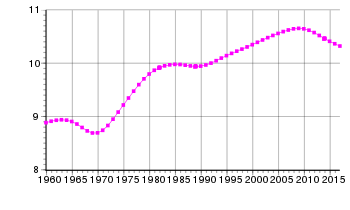
Natural increase current
Source:[13]
- Number of births for January - April 2019 =

- Number of births for January - April 2020 =

- Number of deaths for January - April 2019 =

- Number of deaths for January - April 2020 =

- Natural growth for January - April 2019 =

- Natural growth for January - April 2020 =

Other demographic statistics
The following demographic statistics are from the World Population Review.[14]
- One birth every 7 minutes
- One death every 5 minutes
- One net migrant every 160 minutes
- Net loss of one person every 14 minutes
The following demographic statistics are from the CIA World Factbook, unless otherwise indicated.[12]
- Population
- 10,355,493 (July 2018 est.)
- 10,839,514 (July 2017 est.)
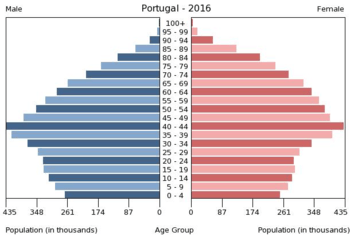
- Age structure
- 0-14 years: 14.01% (male 743,277 /female 707,437)
- 15-24 years: 10.89% (male 580,709 /female 546,908)
- 25-54 years: 42.04% (male 2,143,735 /female 2,209,736)
- 55-64 years: 12.8% (male 605,113 /female 720,192)
- 65 years and over: 20.26% (male 838,606 /female 1,259,780) (2018 est.)
- 0-14 years: 15.34% (male 866,004/female 797,004)
- 15-24 years: 11.36% (male 653,672/female 577,800)
- 25-54 years: 41.72 (male 2,298,920/female 2,223,184)
- 55-64 years: 12.18% (male 617,036/female 702,992)
- 65 years and over: 19.4% (male 861,270/female 1,241,632) (2017 est.)
- 0–14 years: 16.1% (male 906,062/female 831,992)
- 15–64 years: 65.7% (male 3,548,140/female 3,538,562). The biggest population age group is 35–39.
- 65 years and over: 18.1% (male 800,339/female 1,156,361) (2012 est.)
- Median age
- total: 43.7 years. Country comparison to the world: 17th
- male: 41.8 years
- female: 45.6 years (2018 est.)
- total: 42.2 years
- male: 40.2 years
- female: 44.4 years (2017 est.)
- Birth rate
- 8.2 births/1,000 population (2018 est.) Country comparison to the world: 220th
- 9 births/1,000 population (2017 est.)
- Death rate
- 10.6 deaths/1,000 population (2018 est.) Country comparison to the world: 25th
- Total fertility rate
- 1.39 children born/woman (2018 est.) Country comparison to the world: 213rd
- 1.53 children born/woman (2017 est.)
- Net migration rate
- 2.5 migrant(s)/1,000 population (2017 est.) Country comparison to the world: 38th
- Population growth rate
- -0.2 migrant(s)/1,000 population (2018 est.) Country comparison to the world: 112nd
- 0.04% (2017 est.)
- Mother's mean age at first birth
- 30.2 years (2015 est.)
- Life expectancy at birth
| Period | Life expectancy in Years |
Period | Life expectancy in Years |
|---|---|---|---|
| 1950–1955 | 60.3 | 1985–1990 | 74.0 |
| 1955–1960 | 62.4 | 1990–1995 | 74.9 |
| 1960–1965 | 64.5 | 1995–2000 | 76.0 |
| 1965–1970 | 66.4 | 2000–2005 | 77.6 |
| 1970–1975 | 68.3 | 2005–2010 | 79.3 |
| 1975–1980 | 70.4 | 2010–2015 | 80.5 |
| 1980–1985 | 72.5 | 2015-2019 | 82.0 |
Source: UN World Population Prospects[15]
- Religions
Roman Catholic 81%, other Christian 3.3%, other (includes Jewish, Muslim, other) 0.6%, none 6.8%, unspecified 8.3% note: represents population 15 years of age and older (2011 est.)
- Infant mortality rate
- total: 4.3 deaths/1,000 live births. Country comparison to the world: 189th
- male: 4.8 deaths/1,000 live births
- female: 3.9 deaths/1,000 live births (2017 est.)
- Infant mortality rate
| Year | Deaths/1,000 live births |
| 2000 | 5.5 |
| 2001 | 5.0 |
| 2002 | 5.0 |
| 2003 | 4.1 |
| 2004 | 3.8 |
| 2005 | 3.5 |
| 2006 | 3.3 |
| 2007 | 3.4 |
| 2008 | 3.3 |
| 2009 | 3.6 |
| 2010 | 2.5 |
| 2011 | |
| 2012 | 4.6 |
| 2017 | 4.3 |
- Dependency ratios
- total dependency ratio: 53.4
- youth dependency ratio: 21.6
- elderly dependency ratio: 31.8
- potential support ratio: 3.1 (2015 est.)
- Urbanization
- urban population: 65.2% of total population (2018)
- rate of urbanization: 0.47% annual rate of change (2015-20 est.)
- Literacy
definition: age 15 and over can read and write (2015 est.)
- total population: 99.9%
- male: 100%
- female: 99% (2015 est.)
- School life expectancy (primary to tertiary education)
- total: 16 years
- male: 16 years
- female: 16 years (2016)
- Unemployment, youth ages 15–24
- total: 23.9%. Country comparison to the world: 51st
- male: 22.4%
- female: 25.5% (2017 est.)
- Sex ratio
- at birth: 1.07 male(s)/female
- under 15 years: 1.09 male(s)/female
- 15–64 years: 1 male(s)/female
- 65 years and over: 0.69 male(s)/female
- total population: 0.95 male(s)/female (2011 est.)
Urban organization
Metropolitan areas and agglomerations
As of 2001 Census, Portugal had two significant agglomerations: Lisbon Metropolitan Region (3.34 million inhabitants) and Northern Littoral Urban-Metropolitan Region (or Porto Metropolitan Agglomeration) with 2.99 million people, the later with a polycentric nature.[16] These broader agglomerations are distinct from the political metropolitan areas of Lisbon and Porto – Grande Área Metropolitana de Lisboa (2,8 million) and Grande Área Metropolitana do Porto (1,8 million). Together they hold 43% of the total population.
| Image | City | Metropolitan area | Subregion | Core municipality |
|---|---|---|---|---|
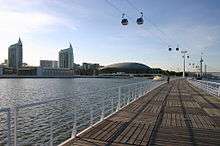 |
Lisbon | 2,846,332[16] | 2,042,326 | 507,220 |
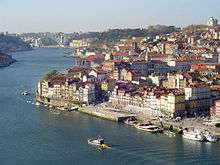 |
Porto | 1,758,531[16] | 1,401,805 | 237,559 |
Largest urban areas
When considering the number of inhabitants in consistent single urban areas, de facto cities in mainland Portugal, per the new with increased density of human-created structures, and excluding suburban and rural areas, Portugal has two cities with about one million inhabitants each (Lisbon and Porto), ten others with more than 50,000 inhabitants and 14 cities with populations between 20,000 and 40,000 inhabitants.[16]
Note: the following table does not include cities in the Portuguese islands of Madeira and Azores in mid-Atlantic Ocean.
| City | Metropolitan Area | Agglomeration |
|---|---|---|
| Cities with about 50,000 inh. (2001 Census) | ||
| Leiria | ||
| Amora | Lisbon Metropolitan Region | |
| Portimão | ||
| Faro | ||
| Évora | ||
| Cities with about 40,000 inh. (2001 Census) | ||
| Viana do Castelo | ||
| Covilhã | ||
| Castelo Branco | ||
| Santarém | Lisbon Metropolitan Region | |
| Alverca do Ribatejo | Lisbon Metropolitan Region | |
| Vila Nova de Famalicão | Northern Littoral Urban-Metropolitan Region | |
| Figueira da Foz | ||
| Guarda | ||
| Caldas da Rainha | Lisbon Metropolitan Region | |
| Olhão | ||
| Santo Tirso | Greater Porto | Northern Littoral Urban-Metropolitan Region |
| Vila Real | ||
| Póvoa de Santa Iria | Greater Lisbon | Lisbon Metropolitan Region |
Largest cities
Portugal has 151 localities with city status (cidade). Every city is included into a municipality (município). This is a list of population by city, which means that it refers to the number of inhabitants in the city proper, excluding inhabitants from the same municipality but living outside the urban area of the city in other civil parishes (freguesias) of the municipality. In some cases, the entire municipality and the city proper cover the same territory.[17]
| Rank | City name | Population | Metropolitan area | Subregion |
|---|---|---|---|---|
| 1 | Lisbon | 547,631 | Greater Metropolitan Area of Lisbon | Grande Lisboa |
| 2 | Porto | 237,584 | Greater Metropolitan Area of Porto | Grande Porto |
| 3 | Vila Nova de Gaia | 186,503 | Greater Metropolitan Area of Porto | Grande Porto |
| 4 | Amadora | 175,135 | Greater Metropolitan Area of Lisbon | Grande Lisboa |
| 5 | Braga | 143,532 | Greater Metropolitan Area of Minho | Cávado |
| 6 | Funchal | 111,892 | Madeira | |
| 7 | Coimbra | 102,455 | Greater Metropolitan Area of Coimbra | Baixo Mondego |
| 8 | Setúbal | 90,640 | Greater Metropolitan Area of Lisbon | Península de Setúbal |
| 9 | Almada | 89,533 | Greater Metropolitan Area of Lisbon | Península de Setúbal |
| 10 | Agualva-Cacém | 79,805 | Greater Metropolitan Area of Lisbon | Grande Lisboa |
| 11 | Queluz | 75,179 | Greater Metropolitan Area of Lisbon | Grande Lisboa |
| 12 | Guimarães | 66,912 | Ave | |
| 13 | Viseu | 66,143 | Dão-Lafões | |
| 14 | Rio Tinto | 64,815 | Greater Metropolitan Area of Porto | Grande Porto |
| 15 | Aveiro | 61,752 | Baixo Vouga | |
| 16 | Odivelas | 59,559 | Greater Metropolitan Area of Lisbon | Grande Lisboa |
| 17 | Matosinhos | 49,486 | Greater Metropolitan Area of Porto | Grande Porto |
| 18 | Amora | 48,629 | Greater Metropolitan Area of Lisbon | Península de Setúbal |
| 19 | Ponta Delgada | 46,102 | Açores | |
| 20 | Portimão | 45,431 | Algarve | |
| 21 | Faro | 44,099 | Algarve | |
| 22 | Leiria | 42,745 | Pinhal Litoral | |
| 23 | Póvoa de Varzim | 42,396 | Greater Metropolitan Area of Porto | Grande Porto |
| 24 | Évora | 41,159 | Alentejo Central | |
| 25 | Barreiro | 40,859 | Greater Metropolitan Area of Lisbon | Península de Setúbal |
| 26 | Maia | 40,134 | Greater Metropolitan Area of Porto | Grande Porto |
| 27 | Ermesinde | 38,798 | Greater Metropolitan Area of Porto | Grande Porto |
| 28 | Viana do Castelo | 38,045 | Alto Minho | |
| 29 | Covilhã | 36,226 | Cova da Beira | |
| 30 | Castelo Branco | 35,242 | Beira Interior Sul |
Largest municipalities by population
Denotes the number of inhabitants in the municipality area; area is in km2; only for populations of over 100,000 inhabitants.
| Rank | Municipality | Population | Land Area | Density | Metropolitan area |
|---|---|---|---|---|---|
| 1 | Lisbon | 547,631 | 84.8 | 6,458 | Greater Metropolitan Area of Lisbon |
| 2 | Sintra | 377,837 | 319.2 | 1,184 | Greater Metropolitan Area of Lisbon |
| 3 | Vila Nova de Gaia | 302,296 | 170.8 | 1,770 | Greater Metropolitan Area of Porto |
| 4 | Porto | 237,584 | 41.3 | 5,753 | Greater Metropolitan Area of Porto |
| 5 | Cascais | 206,429 | 97.4 | 2,119 | Greater Metropolitan Area of Lisbon |
| 6 | Loures | 205,054 | 169.3 | 1,211 | Greater Metropolitan Area of Lisbon |
| 7 | Braga | 181,474 | 183.2 | 991 | |
| 9 | Matosinhos | 175,478 | 62.2 | 2,821 | Greater Metropolitan Area of Porto |
| 9 | Amadora | 175,135 | 23.8 | 7,359 | Greater Metropolitan Area of Lisbon |
| 10 | Almada | 174,030 | 70.0 | 2,486 | Greater Metropolitan Area of Lisbon |
| 11 | Oeiras | 172,120 | 45.7 | 3,766 | Greater Metropolitan Area of Lisbon |
| 12 | Gondomar | 168,027 | 133.3 | 1,261 | Greater Metropolitan Area of Porto |
| 13 | Seixal | 158,269 | 95.5 | 1,657 | Greater Metropolitan Area of Lisbon |
| 14 | Guimarães | 158,124 | 241.3 | 655 | |
| 15 | Odivelas | 144,549 | 26.4 | 5,475 | Greater Metropolitan Area of Lisbon |
| 16 | Coimbra | 143,396 | 319.0 | 450 | |
| 17 | Santa Maria da Feira | 139,312 | 215.1 | 648 | Greater Metropolitan Area of Porto |
| 18 | Vila Franca de Xira | 136,886 | 317.7 | 431 | Greater Metropolitan Area of Lisbon |
| 19 | Maia | 135,306 | 83.7 | 1,617 | Greater Metropolitan Area of Porto |
| 20 | Vila Nova de Famalicão | 133,832 | 201.7 | 664 | |
| 21 | Leiria | 126,879 | 564.7 | 225 | |
| 22 | Setúbal | 121,185 | 171.9 | 705 | Greater Metropolitan Area of Lisbon |
| 23 | Barcelos | 120,391 | 378.9 | 318 | |
| 24 | Funchal | 111,892 | 75.7 | 1,478 |
People
Nationality
- noun: Portuguese (singular and plural)
- adjective: Portuguese
Languages
The main language is Portuguese. Mirandês (the Mirandese language), is also recognised, and has special protection in the area of Miranda do Douro.
Immigration
In 1992, 1.3% of the population was foreign, by 2007 the number had grown to 4.1% or 435,736 people.[18]
Since the independence of the former African colonies, Portugal saw a steady immigration from Africa, most notably Cape Verde, Angola and Guinea-Bissau, but also São Tomé and Príncipe, Mozambique and former Portuguese India in Asia.
Portugal saw migration waves due to labor shortages since 1999, first from Eastern Europe (1999–2002), in two distinctive groups, a Slav (Ukraine, Russia and Bulgaria) and an East Latin (Romania and Moldavia), that stopped and started declining as the labour market became saturated.
Since 2003, most of the immigrants came from Brazil, China and the Indian subcontinent. Family reunification was seen as important for a successful integration in the country, thus the government eased it, and in 2006, more than 6 in 10 new immigrants were family members of legal foreign residents in the country.[19]
There is also a significant number of elderly Western European residents in search of quality of life, namely from France, German, the Netherlands and United Kingdom.
| Nationality | Population (2019)[20] |
|---|---|
| 151,304 | |
| 37,436 | |
| 34,358 | |
| 31,065 | |
| 29,718 | |
| 27,839 | |
| 25,408 | |
| 23,125 | |
| 22,691 | |
| 18,886 | |
| 17,619 | |
| 16,849 | |
| 15,848 | |
| 14,669 | |
| 10,241 | |
| 10,038 | |
| 7,964 | |
| 6,839 | |
| 6,551 | |
| 5,310 | |
| Acquisition of portuguese citizenship[21] | |
| Previous citizenship | Number in 2017 |
|---|---|
| 6,084 | |
| 2,591 | |
| 1,909 | |
| 1,226 | |
| 1,225 | |
| 753 | |
| 693 | |
| 453 | |
| 412 | |
| 319 | |
Ethnic minorities and persons with disabilities
Anti-racism laws prohibit and penalize racial discrimination in housing, business, and health services. In 2007 approximately 332,137 legal immigrants live in the country, representing approximately 5% of the population. The country also has a resident Romani (Gypsy) population of approximately 40,000 people.
Discrimination against persons with disabilities in employment, education, access to health care, or the provision of other state services is illegal. The law mandates access to public buildings and to newly built private buildings for such persons.
Religion
Religions in Portugal (Census 2011)[22]
The great majority of the Portuguese population belongs to the Roman Catholic Church. Religious observance remains strong in northern areas, with the population of Lisbon and southern areas generally less devout and strongly anticlerical. Religious minorities include a little over 300,000 Protestants and Mormons. There are also about 50,000 Muslims and 10,000 Hindus. Most of them came from Goa, a former Portuguese colony on the west coast of India (Some Muslims also came from former two Portuguese African colonies with important Muslim minorities: Guinea-Bissau and Mozambique). There are also about 1,000 Jews. Portugal is also home to less than 10,000 Buddhists, mostly Chinese from Macau and a few Indians from Goa. Portugal is still one of the most religious countries in Europe, most Portuguese believe with certainty in the Existence of God and religion play a big importance in the life of most Portuguese.[23][24] According to the Pew Research Center, 40% of Portuguese Catholics pray daily.[25]
Literacy
- definition: age 15 and over can read and write
- total population: 99.62%
- male: 99.55%
- female: 99.63% (2015)[26]
See also
- Portugal census
- Portugal
- Romani people in Portugal
Notes
- In fertility rates, 2.1 and above is a stable population and has been marked blue, 2 and below leads to an aging population and the result is that the population decreases.
References
- Nuno Valério (coord.), Estatísticas Históricas Portuguesas, Vol. I, pp. 33, 37 e 51. INE, 2001. (PDF: 4,18 MB)
- INE, CENSOS 2001 Resultados Definitivos, Informação à Comunicação Social, 21 October 2002.
- INE, Estimativas de População Residente, Portugal, NUTS II, NUTS III e Municípios – 2006, Informação à Comunicação Social, 3 August 2007.
- "Portugal Ethnic Groups | Study.com". Study.com. Retrieved 11 April 2017.
- Max Roser (2014), "Total Fertility Rate around the world over the last centuries", Our World In Data, Gapminder Foundation
- B.R. Mitchell. European historical statistics, 1750–1975.
- "United Nations. Demographic Yearbook 1948" (PDF). Unstats.un.org. Retrieved 3 October 2017.
- "Statistics Portugal". Ine.pt. Retrieved 3 October 2017.
- "PORDATA – População residente: total e por sexo". Pordata.pt. Retrieved 3 October 2017.
- "2011 WORLD POPULATION DATA SHEET" (PDF). Prb.org. Retrieved 3 October 2017.
- "2012 – Negative birth rate decreases further – Portugal – Portuguese American Journal". Portuguese-american-journal.com. Retrieved 3 October 2017.
- "World Factbook EUROPE : PORTUGAL", The World Factbook, 12 July 2018
- "Monthly Statistical Bulletin". Instituto Nacional de Estatística. Statistics Portugal. Retrieved 22 July 2020.
- World Population Review: Portugal Population 2018, 14 June 2018
- "World Population Prospects – Population Division – United Nations". Retrieved 15 July 2017.
- Fernando Nunes da Silva (2005), Alta Velocidade em Portugal, Desenvolvimento Regional, CENSUR, IST Archived 24 June 2009 at the Wayback Machine
- UMA POPULAÇÃO QUE SE URBANIZA, Uma avaliação recente – Cidades, 2004 Archived 6 October 2014 at the Wayback Machine Nuno Pires Soares, Instituto Geográfico Português (Geographic Institute of Portugal)
- População Estrangeira em Território Nacional (pdf) (in Portuguese), SEF, 2008, retrieved 12 September 2008
- Imigração: Novos imigrantes legais em Portugal aumentaram 50% em 2006 – OCDE Archived 10 February 2012 at the Wayback Machine – RTP.pt
- https://sefstat.sef.pt/Docs/Rifa2019.pdf
- https://ec.europa.eu/eurostat/web/products-eurostat-news/-/WDN-20190723-1
- "Census – Final results : Portugal – 2011". Statistics Portugal. 20 November 2012. Retrieved 21 November 2012.
- Portugueses são mais cristãos e vão mais à igreja do que o resto da Europa ocidental
- Portugal é dos países onde mais pessoas garantem que Deus existe
- Five Centuries After Reformation, Catholic-Protestant Divide in Western Europe Has Faded Pew Research Center.
- "Portugal". Uis.unesco.org. Retrieved 3 October 2017.




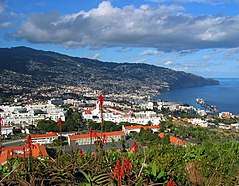
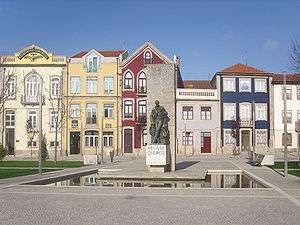
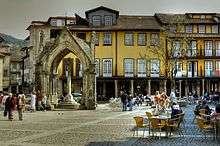

.png)